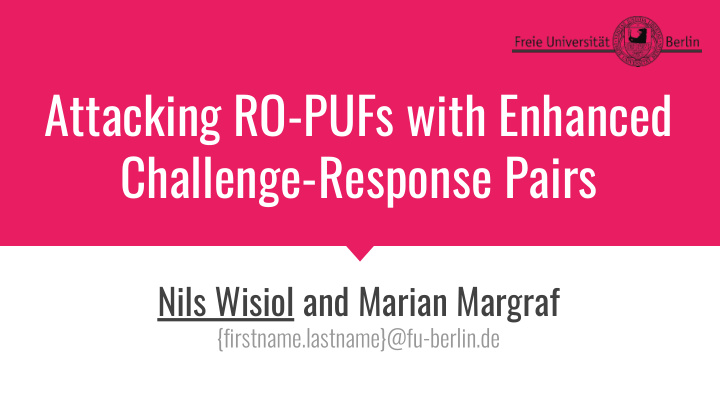



Attacking RO-PUFs with Enhanced Challenge-Response Pairs Nils Wisiol and Marian Margraf {firstname.lastname}@fu-berlin.de
1. Physically Unclonable Functions 2. Ring Oscillator PUF with Enhanced Outline Challenge-Response Pairs 3. Attack 4. Discussion 5. Future Work 6. Q/A
I. Physically Unclonable Functions
Physically Unclonable Functions Identical circuit design ● Behavior different on each chip ● Formalized by a ○ challenge-response schema Hard to clone, physically or ● otherwise How many challenges does it ● have? 1 1 “Weak” PUF ○ 1 0 1 1 1 1 0 00 0 1 “Strong” PUF 01 ○ 1 11 Image credit: Zhenni Li
Ring Oscillator Physically Unclonable Functions Cheap and effective method for ● implementation of PUFs on FPGAs Ring of inverters ● Oscillates with ● hardware-intrinsic frequency One PUF has an array of n ● oscillators ... Challenge selects two, response ● tells us which one has higher frequency “Weak”, i.e. small number of ● challenge-response pairs Image credit: Maiti, Abhranil, and Patrick Schaumont. "Improved ring oscillator PUF: an FPGA-friendly secure primitive." Journal of cryptology 24.2 (2011): 375-397.
II. RO-PUF with Enhanced Challenge-Response Pairs Delavar, Mahshid, Sattar Mirzakuchaki, and Javad Mohajeri. "A Ring Oscillator-based PUF with enhanced challenge-response pairs." Canadian Journal of Electrical and Computer Engineering 39.2 (2016): 174-180.
Enh-RO-PUF: Setup Choose an instance-specific seed S of n -1 random bits ● n ring oscillators have frequencies f i ● The comparison vectors φ ( i ) indicate for each ring, if ● the other rings oscillate faster or slower The RO-PUFs secret
Enh-RO-PUF: Challenge and Response Challenge C is any subset { c 1 , c 2 ,…, c k } of {1,2,…, n } ● For each challenge C , we shift the seed S by c 1 + c 2 +…+ c k ● bit. For the shifted seed we write ρ ( C ) Note that ρ ( C ) = ρ ( C ∪ { n -1}) Finally, the response for challenge C is ● res( C ) = φ (c 1 ) ⊕ … ⊕ φ (c k ) ⊕ ρ ( C ) XOR of all the Shifted seed intended to comparison vectors for mask the output rings selected by the input
III. Attack
Attack Step One: Recover φ ( n -1) using 2 Queries Shift operation ρ of seed S is cyclic ● ρ ( C ) = ρ ( C ∪ { n -1}) ○ Choose challenges C 1 = {1}, C 2 = {1, n -1} ● res( C 1 ) = φ (1) ⊕ ρ ( C 1 ) res( C 2 ) = φ (1) ⊕ φ (n-1) ⊕ ρ ( C 2 ) res( C 1 ) ⊕ res( C 2 ) = φ (n-1) ⊕ ρ ( C 1 ) ⊕ ρ ( C 2 ) = 0
Attack Step Two: Recover Seed S Choose challenges C 3 = {n-1} ● res( C 3 ) = φ (n-1) ⊕ ρ ( C 3 ) = φ (n-1) ⊕ S Known from attack step one using 1 Query
Attack Step Three: Recover All Other Comparison Vectors φ ( n-1 ) known from step one ● φ ( 1 ) known after step two: we had res( C 1 ) = φ (1) ⊕ ρ ( C 1 ) ● To recover φ ( i ), Choose challenge C = { i } ● res( C ) = φ ( i ) ⊕ ρ ({ i }) using Known from n -2 queries attack step two
All secrets recovered after n +1 chosen queries
IV. Discussion
Security Implications We only break one proposed ● design choice of Delavar et al. Other design choices are ● secured by additional crypto primitives and hence out of scope Attack shown for ● attacker-chosen challenges, but can be extended to passive attacks Breaks all protocols based on ● the primitive
How did This Happen? Some assumptions used in the security analysis do not ● hold, e.g. Different challenges are not xored with unique random vectors, but with shifted versions of a single random vector Important design choices left open, e.g. ● Seed generation once or every time? Some conclusions used in the security analysis are not ● sound, e.g. High uniqueness does not imply unclonability
Future Work
How to Build Secure Strong PUFs? Still no secure strong PUF known ● Failed attempts: ● Arbiter PUF by Gassend and Lim (attack also by Gassend and Lim) ○ XOR Arbiter PUF by Suh and Devadas (attack by Rührmair et al.) ○ Bistable Ring PUF by Chen et al. (attack by Xu et al.) ○ Ring Oscillator Sum PUF by Yu and Devadas (attack by Becker et al.) ○ Not yet failed attempts: ● Majority Vote XOR Arbiter PUF by myself (2017) ○ (modified) Arbiter PUF once more by Mispan et al. (2018) ○ Coin-Flipping PUF by Tanaka et al. (2018) ○ Dual-Mode PUF by Wang et al. (2018) ○ Let’s turn to cryptographic constructions! ●
Nils Wisiol Marian Margraf Questions & Freie Universität Berlin Answers http://idm.mi.fu-berlin.de firstname.lastname@fu-berlin.de DOI: 10.1007/978-3-319-99828-2 Attacking RO-PUFs with 24th IFIP World Computer Enhanced Challenge-Response Congress, TC-11 SEC, 18. Sep Pairs 2018, Poznan, Poland
Recommend
More recommend